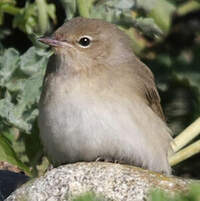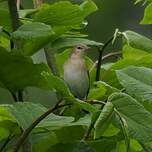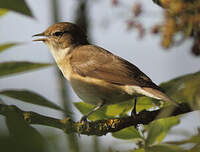Garden Warbler
Sylvia borin - Fauvette des jardins
Identification
The Garden Warbler is a sturdy warbler, more so than the Blackcap. Unlike the latter which is easily recognized by its cap, the Garden Warbler has drab plumage, without any striking features, making its identification tricky for the beginner. Luckily in spring, it reveals itself through its melodious song. The upperparts, body and wing coverts, are a brown-grey shade streaked with olive. The primaries and rectrices are dark brown, but with external edges the same color as the previous ones, giving the upperparts a very uniform and plain look. The underparts are pale, almost white on the throat, belly and especially the undertail. The top color blends into the chest in a diffused pectoral, and the sides are slightly reddish. A grey collar is visible on the sides of the neck. The dark eye is surrounded by a cream-white eye-ring. A dark line, loral followed by post-ocular, is barely noticeable. The short, quite thick, beak is brown, with the base a bit lighter. The legs are brown-grey.
Subspecific information 2 subspecies
- Sylvia borin borin (w, c and n Europe)
- Sylvia borin woodwardi (Poland and Ukraine to c Siberia)
Foreign names
- Fauvette des jardins,
- Curruca mosquitera,
- toutinegra-das-figueiras,
- Gartengrasmücke,
- kerti poszáta,
- Tuinfluiter,
- Beccafico,
- trädgårdssångare,
- Hagesanger,
- penica slávikovitá,
- pěnice slavíková,
- Havesanger,
- lehtokerttu,
- Tuinsanger,
- tallarol gros,
- Garðsöngvari,
- gajówka,
- dārza ķauķis,
- vrtna penica,
- Садовая славка,
- ニワムシクイ,
- 庭园林莺,
- trädgårdssångare,
- 園林鶯,
Voice song and call
The Garden Warbler has an remarkable voice. Its elaborate, melodic and constant-toned song seems to flow without effort, which easily distinguishes it from its relatives. It may be slightly stammering and grating at the beginning, which may be confusing, but it quickly picks up. This warbler does not have the loud cries of its black-headed cousin. On the other hand, the latter can imitate it, but sooner or later the typical outbursts return. The usual cry consists of the repetition of the same note tjet tjet tjet tjet ... , very characteristic and can be prolonged. This is the alarm cry emitted when entering its territory until the danger passes away.
Habitat
The Garden Warbler bears its name poorly as it is not actually a bird of man-cultivated spaces. It is often close to the Blackcap, but the latter has a wider range of habitats, is more opportunistic and therefore more widespread.
Behaviour character trait
The Garden Warbler is a great migrator. You can tell by its wing shape. It spends winter in the boreal Africa south of the Sahara.
It comes back to the European continent in April and May, so fairly late, but the northernmost ones come only in late May or early June. Western birds travel through Spain, those in the heart of the continent through Italy, and the eastern ones through Middle East and the Arabic peninsula. It's a territorial bird in its breeding grounds. The male defends its territory with song, and the female is more discreet.Flight
Dietfeeding habits
The Garden Warbler is an insectivore all year round, but particularly during breeding season. It feeds its young with insects, with an important place for aphids and various larvae in the diet. The rest of the year it is like the blackbird and is very fond of fruits such as figs, blackberries of Rubus, etc. It also knows how to take advantage of time or space sources such as pollen and nectar.
Reproduction nesting
In central Europe, breeding takes place at the very end of April and in May. The species is monogamous.
The male is territorial and announces his presence with his voice. He builds rudimentary nests but the choice is left to the female. She completes one of the rudimentary nests or builds a new one, aided by her mate, with herbaceous twigs or dry linear leaves which she binds onto the branches of a fork in a dense shrub. The interior of the cup is lined with finer, dry vegetal elements and hair. She lays 4 or 5 white, brown-spotted eggs, mainly at the larger end. The couple takes turns to incubate the eggs for 10 to 11 days. After hatching, the young will remain dependent on their parents for another 2 weeks. At middle latitudes, a second clutch is possible.Geographic range
The breeding range extends in longitude from the Atlantic coasts to the centre of Russia and in latitude from the North Cape to the Mediterranean coasts of Europe, south of the Black Sea, the Caucasus, north of the Caspian Sea and Kazakhstan. The species is absent from the Mediterranean islands, most of Italy, Greece and most of Asia Minor. The wintering range is sub-Saharan and extends from the Sahel to the east of South Africa. The flight's power allows the species to migrate over a wide front, from Spain to the Arabian Peninsula, without neglecting the ease of the Strait of Gibraltar and the Bosphorus.
Threats - protection
IUCN conservation status
concern
in the Wild
threatened
evaluated
The Garden Warbler is not classified as an endangered species. It is still common in its range. Habitat destruction may be a problem for the species, such as the invasion of wetland areas by the invasive Knotweed Reynutria ssp. Changes to the climate in Africa, which causes more droughts, will inevitably have an impact on the species' survival, especially in migratory stopovers where it must be able to feed enough to continue its journey.
Sources of information
- IOC World Bird List (v14.2), Gill, F and D Donsker (Eds). 2024-04-18.
- Les passereaux d'Europe, tome 2, P. Géroudet, M. Cuisin
- Warblers, Dunn Jon/Garrett Kimball
- Avibase, Lepage Denis
- Birds of the World, The Cornell Lab of Ornithology
- xeno-canto, Sharing bird sounds from around the world,
Other sources of interest
 Specification sheet created on
12/07/2023 by Jean François
Specification sheet created on
12/07/2023 by Jean FrançoisTranslation by AI Oiseaux.net
© 1996-2025 Oiseaux.net
- Accipitriformes
- Aegotheliformes
- Anseriformes
- Apodiformes
- Apterygiformes
- Bucerotiformes
- Caprimulgiformes
- Cariamiformes
- Casuariiformes
- Charadriiformes
- Ciconiiformes
- Coliiformes
- Columbiformes
- Coraciiformes
- Cuculiformes
- Eurypygiformes
- Falconiformes
- Galliformes
- Gaviiformes
- Gruiformes
- Leptosomiformes
- Mesitornithiformes
- Musophagiformes
- Nyctibiiformes
- Opisthocomiformes
- Otidiformes
- Passeriformes
- Pelecaniformes
- Phaethontiformes
- Phoenicopteriformes
- Piciformes
- Podargiformes
- Podicipediformes
- Procellariiformes
- Psittaciformes
- Pterocliformes
- Rheiformes
- Sphenisciformes
- Steatornithiformes
- Strigiformes
- Struthioniformes
- Suliformes
- Tinamiformes
- Trogoniformes





























